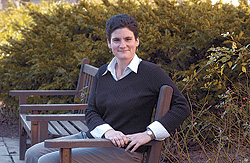


 |
Issue Contents :: Around Tappan
Square :: Page [ 1 2 3 4 5 6 7 8 ]
Changing Faces
Alumni Association
kicks off year with new
executive director
 |
| photo by Al Fuchs |
The Oberlin Alumni Association begins a new era of leadership this January with the arrival of Laura M. Gobbi '91, a 10-year museum scientist at the history of art department at UC-Berkeley. Gobbi assumes the role held by Midge Wood Brittingham '60, who retires January 30 after 28 years as executive director.
Studying at both the College and Conservatory, Gobbi majored in art history and took courses in flute performance. She earned a master's degree at the Insti-tute of Fine Arts at New York University before moving to Berkeley in 1993 to oversee a 400,000-piece visual resources collection used by graduate students and faculty. An active volunteer in the Bay Area, Gobbi co-coordinated Oberlin's admissions efforts there by organizing Interview Days and alumni networking events, and by serving as a career mentor to new graduates.
Within the larger community, she planned charity events to benefit research efforts for AIDS, leukemia, and MS.
OAM: You're obviously no stranger to the higher
education environment. What excites you about returning to Oberlin?
Gobbi:
I'm very excited about bringing the Alumni Association into a new
era, most especially in trying to bridge what some perceive as a disconnect
between the Oberlin of today and the campus known by our older alumni.
I'm
also excited to
be back in a close-knit community where everyone is engaged in a range
of studies and activities. I'm considering the prospect of studying flute
again, which I haven't done privately since I was here, and I certainly
look forward
to being surrounded by musicians again.
Any concerns?
The winter! I've definitely worked winter out of my system over the past
13 years, and I'll have to re-acclimate.
When your appointment was announced to members
of Oberlin's alumni e-mail
discussion group, someone joked: "See, who says you can't find a
job as an art history major?" Any response?
You know, someday I'm going to write
an essay titled "In Defense of Art History." I'm always surprised
by the stereotype, because art history is a very demanding major—I suppose
it bears the brunt of being the "truest" humanities major. It requires
the study of other subjects, such as classics or literature, as well as foreign
language acquisition, strong writing skills, travel, living abroad, teaching
ability—all of which require focus, discipline, negotiating skills, and
creativity.
These skills have certainly served me in many ways: as a visual resources
curator, an art consultant with my own business, and even in my capacity
as a team leader
for volunteer organizations.
As an admissions recruiter, how would you characterize the students
who are most serious about coming to Oberlin?
The students I've interviewed are extremely gifted. Although diverse in
their academic or musical interests, they share the characteristic of being socially
aware and active. I'm always amazed at the gamut of activities that high
school students are involved in. A student I interviewed last year was interested
in Oberlin because he could pursue the study of baroque flute while creating
a major that combined environmental studies and architecture. He ended up enrolling.
How did your own Oberlin experience shape the person you are now?
Oberlin was the first place in which I came to truly respect the strength
of diversity. I learned to work outside my own opinion and experience
a place in my mind where I was not totally comfortable or accustomed
to being.
I'm
now driven by the challenges of being in that space—it's where growth
really takes place.
Your favorite hangout as a student?
The Disco! In the spring months, it was the Arb. Although, if I were
a student now, it would have to be the café at Oberlin Music.
Your most memorable professor?
William Hood, a superb professor of renaissance art who opened
my eyes and taught me to trust my vision. He challenged and inspired
me, and
his passion
for art
is contagious.
What about Oberlin most concerns its alumni?
As I mentioned earlier, there may exist a disconnect between
the Oberlin of today and the Oberlin of our past. I hope to
minimize this by bringing
more
alumni
back to campus and together regionally.
Do you have any preliminary goals?
I'd like to more effectively engage Con-servatory alumni, because
they're
such a huge and important part of our alumni body. I'd
like to reach out to graduating seniors and get them involved
in the Association while they're
still on campus and make them aware of their alumni family.
I'd also like
to merge our graduates' own social interests—be
it with charity races, Sierra Club, etc.—with Association-sponsored
activities. One reason, perhaps, that younger alumni don't
participate in more alumni events is that they have other
interests and only X amount of time. This way they can feel
connected
to Oberlin while contributing to the society at large.
If you could ask Midge Brittingham just one question, what
would it be?
Can she leave me an instruction manual?